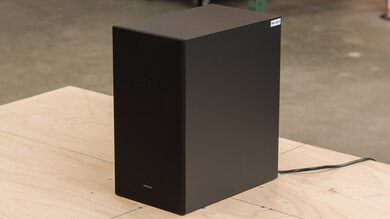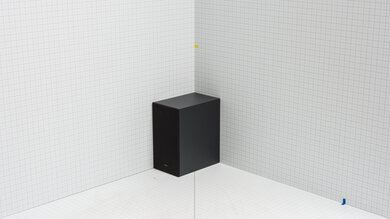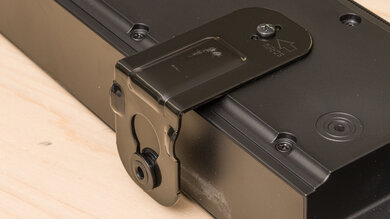The Samsung HW-B650 is a 3.1 soundbar released in 2022. It's the next generation of the Samsung HW-A650, and overall, its performance resembles its predecessor. It's a simple bar with a similar design to the Samsung HW-B550 and the Samsung HW-B450 but with an included center channel to improve vocal reproduction. It doesn't offer as many features as Samsung's more premium models, like room correction or Dolby Atmos support, but you still have a graphic EQ on hand to improve its sound.
Our Verdict
The Samsung HW-B650 is decent for mixed usage. It's a 3.1 bar suitable for many different types of audio content, with clear and accurate reproduction of sound right out of the box. It can also playback 5.1 surround sound formats like Dolby Digital, which you often find on streaming platforms, though its performance isn't the most immersive. Unfortunately, there's no Dolby Atmos support to help you take advantage of more immersive object-based audio formats.
-
Graphic EQ.
-
Gets loud.
-
Lacks some low-bass.
-
No Dolby Atmos support.
The Samsung HW-B650 is great for dialogue-heavy podcasts and TV shows. With its discrete center channel, it reproduces dialogue with more clarity than more budget-friendly 2.1 models. Its balanced mids ensure that voices are accurate and detailed in the mix, and there's even a dialogue enhancement mode to make voices more crisp if you want. You can stream podcasts to the bar over Bluetooth, but unfortunately, there's no support for other wireless playback options.
-
Dialogue enhancement tool.
-
Bluetooth compatible.
-
No Wi-Fi, Apple AirPlay, or Chromecast support.
The Samsung HW-B650 is good for music. Out-of-the-box, its balanced mids ensure that voices and lead instruments reproduce with clarity and detail. As a result, it's suitable for listening to most music genres, and you have lots of customization tools on hand to get it to sound how you want. Its dedicated sub can't reproduce a very extended low-bass, so you notice a lack of rumble in bass-heavy genres like EDM and hip-hop.
-
Graphic EQ.
-
Gets loud.
-
Lacks some low-bass.
The Samsung HW-B650 is fair for movies. Dialogue is clear and present in the mix thanks to its balanced mids, and there are many customization tools to help you get the most from its sound. It can playback 5.1 surround sound formats like Dolby Digital, which you often find on streaming platforms. However, since it's a 3.1 bar, it has to downmix surround sound into stereo. For a more clear and real sound, you can always add a separate rear speaker kit from the manufacturer.
-
Graphic EQ.
-
Dialogue enhancement tool.
-
Lacks some low-bass.
-
No Dolby Atmos support.
- 7.4 Mixed Usage
- 8.1 Dialogue/TV Shows
- 7.7 Music
- 6.8 Movies
- Updated May 28, 2024: Updated Stereo Dynamics results with new methodology from TBU 1.3. Added text to Audio Latency: ARC, Audio Latency: HDMI In, and Audio Latency: Optical boxes.
- Updated May 27, 2024: We've converted this review to Test Bench Update 1.3. If applicable, we've retested stereo sound based on the manufacturer's recommendations. Additionally, we've expanded our audio latency tests to the following boxes: Audio Latency: ARC, Audio Latency: HDMI In, and Audio Latency: Optical. You can see the full changelog here.
- Updated Mar 21, 2024: We've added a comparison between this soundbar and the Hisense HS2100 in Center.
- Updated Aug 17, 2023: Updated the review text for clarity. No changes in test results.
- Updated Jul 25, 2023: Added market comparison with the Samsung HW-Q60C in the Height (Atmos) box.
- Updated Jun 02, 2023: Converted to Test Bench 1.2. Updated the results for audio format support via ARC/eARC, HDMI In, and Optical. Added Video Passthrough to TV results as well.
- Updated Mar 07, 2023: Added cable lengths to In The Box.
- Updated Mar 06, 2023: Converted to Test Bench 1.1. With this update, we've added a Mounting test and added information aboutSubwoofer Output, Spotify Connect, and Microphone Mute.
- Updated Feb 21, 2023: Added market comparison with the Samsung HW-Q600B to the Height (Atmos) box.
- Updated Jul 22, 2022: Review published.
- Updated Jul 18, 2022: Early access published.
- Updated Jun 27, 2022: Our testers have started testing this product.
- Updated Jun 17, 2022: The product has arrived in our lab, and our testers will start evaluating it soon.
- Updated Jun 08, 2022: We've purchased the product and are waiting for it to arrive in our lab.
Differences Between Sizes And Variants
The Samsung HW-B650/ZA is available in 'Black'. You can see the label for the model we tested here.
If you come across another version of this bar, let us know in the forums, and we'll update our review.
Compared To Other Soundbars
This 3.1 soundbar offers similar performance to last year's Samsung HW-A650. It also sounds similar to the Samsung HW-B550, but its discrete center channel improves the quality of vocal reproduction. It's ideal for stereo content like music and TV shows, and you can always add rear speakers from the manufacturer to improve its surround sound.
See our recommendations for the best soundbars, the best soundbars under $300, and the best Samsung soundbars.
The Samsung HW-B650 and the Sony HT-G700 are two very different 3.1 bars. The Sony is unique, with Dolby Atmos support to let you take advantage of more immersive object-based formats. That said, it has to downmix this audio into surround, which doesn't sound very immersive. The Samsung is the better choice for stereo content, with more bass right out of the box and a wider array of sound enhancement features. It has less compression at max volume, too.
The Samsung HW-B650 is the next generation of the Samsung HW-A650. They're both 3.1 bars with similar sounds right out of the box, and their customization tools make it easy to get a different sound. You don't notice much difference between their performances, so it's best to go with the cheaper option.
The Samsung HW-Q60B is a more versatile 3.1 bar than the Samsung HW-B650, especially for movie lovers. Unlike the B650, the Q60B supports Atmos content. It has to downmix it into stereo to play it, though. If you watch a lot of Atmos movies on streaming platforms, go with the Q60B, but if you don't watch them, the B650 is a better value.
The Samsung HW-B650 is better than the Samsung HW-B550. They're both similar bars with similar sounds right out of the box and lots of customization tools on hand. However, the B650 adds a discrete center, which improves vocal clarity. The B550 remains a good option for those looking for a more budget-friendly choice.
The Samsung HW-Q60C/Q6CC is a more versatile soundbar than the Samsung HW-B650. They're both 3.1 setups, but the Q60C supports more audio formats. For example, it supports Dolby Atmos, Dolby Digital Plus, and Dolby TrueHD. It's not "true" support since it has to downmix these formats into stereo, but it's better than nothing.
The Samsung HW-Q600B and the Samsung HW-B650 are both 2022 releases from the manufacturer. The main difference between these two bars comes in support for height content like Dolby Atmos, which is often found on different streaming platforms. The Q600B supports height content, while the B650 doesn't.
The Samsung HW-Q600A is a more versatile bar than the Samsung HW-B650. As a 3.1.2 bar, the Q600A comes with Dolby Atmos support. Unlike the B650, you can use it to take advantage of more immersive object-based formats, usually found on streaming platforms.
The Samsung HW-B650 is a better overall soundbar than the Hisense HS2100, but this is to be expected given its higher price. Both bars have similarly balanced sound profiles and are compatible with Dolby Digital and DTS, though they have to downmix these to stereo. While the Hisense has a 2.1 configuration, the Samsung features a discrete center channel that improves vocal and dialogue clarity. The Samsung also has less compression present when you crank the volume and more sound enhancement features.
The Klipsch Cinema 600 is better than the Samsung HW-B650 for most uses. They're both 3.1 bars, but the Klipsch model has a better soundstage to immerse you in your audio. It's also able to reproduce more low-bass, so you feel the rumble in bass-heavy music genres. However, if you mostly listen to audio without a lot of bass mixed in, like dialogue-heavy TV shows and music, the more affordable Samsung is likely a better pick.
The Klipsch Cinema 800 is better than the Samsung HW-B650 for most uses. They're both 3.1 bars, but the Klipsch can reproduce more low-bass, so you feel the rumble in bass-heavy music genres. It has a better soundstage, too, and unlike the Samsung, there's Dolby Atmos support to help you take advantage of more immersive object-based formats, though its performance isn't the best.
Test Results
This soundbar has a similar design to the Samsung HW-B550. It's mostly made of plastic, with a metal grille covering the front and the sides. The edges of the bar have an angled design, which makes it stand out from last year's model, the Samsung HW-A650.
While this soundbar doesn't come with satellites, you can add a Wireless Rear Speaker Kit separately.
This setup has great build quality. The bar's mostly made of plastic, which feels solid and durable, and the metal grilles help protect the drivers inside. The sub's mostly made of wood. Unfortunately, the fabric in front is loose and thin, and it easily collects dust. It could rip easily, too, so it's worth handling with care.
This soundbar has a very good stereo frequency response. Its sound is similar to last year's Samsung HW-A650, with a pretty clear and accurate reproduction of lead instruments in the mix. There's a little extra brightness compared to last year's model, but it's still a suitable choice for most music genres. That said, there's still a lack of low-bass, which is especially noticeable with bass-heavy genres like EDM and hip-hop. Customization tools like a graphic EQ are on hand to switch up its performance if you like, though these won't have much of an impact on the low-bass extension since it isn't designed to adjust at these lower frequencies.
A response that follows our Harman-based target curve is pleasing to most kinds of listeners. We recommend using this bar with its default settings if you want this sound.
The soundstage is perceived to be about as wide as the bar itself, but it doesn't have any tricks to make it seem wider than that. The focus is good, though, so sound effects localize to accurate locations in the soundstage around you. For example, in songs like Queen's Bohemian Rhapsody, you notice that some voices come from the right speaker, and others come from the left speaker as intended by those who mixed the track.
This bar has excellent stereo dynamics. It gets loud enough to fill your living room with sound. There's a little bit of compression when you push it to max volume, especially in the bass range, but it doesn't noticeably impact your audio quality. As a result, you get a clean and clear sound, even at loud volumes.
The Samsung HW-B650 soundbar has a great center channel performance. It's a 3.1 bar with a discrete center channel, differentiating it from 2.1 bars like the Hisense HS2100, and this brings improved dialogue clarity. The frequency response is quite balanced, too, especially in the mids, where most voices reproduce, so you can easily follow along with the conversation.
This soundbar has a poor surrounds performance. However, this is normal for a 3.1 bar. Since it doesn't have discrete surrounds, it has to downmix 5.1 content like Dolby Digital into stereo to play it. As a result, audio seems like it's just coming from a speaker placed in front of you rather than from speakers placed around you. You can always add a separate rear speaker kit from the manufacturer for a more immersive sound.
For a bar that supports height content, check out the Samsung HW-Q600B or the Samsung HW-Q60C/Q6CC.
The Samsung HW-B650 has a decent selection of sound enhancement features, especially compared to similarly-priced models. Like most mid-range bars, it lacks room correction, so it sounds slightly different depending on your room's acoustics. However, with its bass and treble adjustments and graphic EQ, you have many options to customize its sound. There are many preset modes, including 'Standard', 'Surround Sound', 'Bass Boost', 'Game', 'Adaptive Sound Lite', and 'DTS Virtual X'. The 'Adaptive Sound Lite' mode can enhance audio like dialogue by making voices sound more clear and crisp, while 'DTS Virtual X' works as a virtual surround feature to create a more immersive sound. If you add on rears, you can adjust their levels, too.
You can plug this soundbar into your TV using an HDMI or Optical connection. It comes with an Optical cable, but you need to get an HDMI cable separately if you want to use this connection since one doesn't come in the box.
The Samsung B650 supports Dolby Digital and DTS content over ARC. Both are common 5.1 surround sound formats, often seen on streaming platforms and Blu-rays. However, since it's a 3.1 bar, it has to downmix this content into stereo to play it.
This bar also supports DTS and Dolby Digital via HDMI In. Dolby Digital is the most common surround sound format, which you see on lots of different streaming platforms. DTS is often a fallback for higher-quality DTS-HD MA formats seen on lots of Blu-rays.
The Samsung B650 soundbar also supports Dolby Digital and DTS formats over Optical, which you find on many Blu-rays and streaming platforms.
This bar has an excellent latency performance via ARC. Your audio and visuals stay in sync, which is good if you're watching content like TV shows with a lot of dialogue. Some apps and TVs compensate for latency, though.
Unfortunately, our ARC Latency Video measures AV sync error, and the error measured on the video shows a delay higher than what we tested. We've verified the soundbar and TV settings to ensure that no delay was set, but we are currently looking into this.
The Samsung B650 soundbar also has an excellent latency performance over HDMI In. You can watch audio formats like Dolby Digital without a noticeable delay. It's worth noting that some apps and TVs compensate for latency, though.
Like with our ARC Latency Video, the HMDI In Video measures AV sync error, and the error measured on the video shows a delay higher than what we tested. We've verified the soundbar and TV settings to ensure that no delay was set, but we are currently looking into this.
The latency performance is okay via Optical. Delay is high whether you're playing 2.0 PCM or Dolby Digital content, so you'll notice lip-syncing errors.
This soundbar can passthrough some common resolutions and refresh rates. If you connect it as a hub between your gaming console and your TV, you can enjoy 1080p and 4k content. However, it can't passthrough higher-quality video signals like HDR10, which is disappointing if you want to use it with a Blu-ray player or an Apple TV. It can't passthrough any of the more common variable refresh rate technologies, which is disappointing if you're a gamer searching for a more tear-free experience.
The Samsung B650 soundbar only lets you wirelessly stream audio from your mobile devices to the bar via Bluetooth.
















